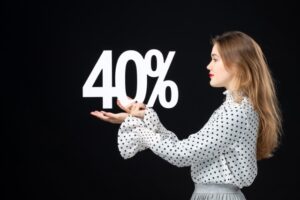Money management: the backbone of foreign exchange trading
Put two brand new currency traders in front of the screen, give them your best high probability lineup, and have each take the opposite side of the trade. The most likely outcome is that both will lose money. But if you take two professionals and have them trade in the opposite direction to each other, quite often both traders will make money – despite it seemingly being a contradiction. What is the difference? What is the main factor that separates the experienced traders from the amateurs? The answer is money management. Like dieting and exercise, money management is something most traders say they put a lot of emphasis on, but few practice in real life. The reason is simple: just like eating healthy and staying fit, money management can seem like a cumbersome, unpleasant activity. It forces traders to constantly monitor their positions and take necessary losses, and few people like to do that. But as Figure 1 shows, loss-taking is crucial to long-term trading success.
| Lost capital | Return required to restore to original value |
| 25% | 33% |
| 50% | 100% |
| 75% | 400% |
| 90% | 1 000% |
Figure 1 – This table shows how difficult it is to recover from a loss. Note that a trader would have to make a return of one hundred percent on his capital – a feat achieved by less than one percent of traders worldwide – just to reach break even on an account with a 50% loss. At 75% loss, our trader would have to quadruple his account just to bring it back to its original capital – truly an impossible task.
The big one
Although most traders know the numbers above, they are inevitably ignored. Trading books are filled with stories of traders who lost one, two, even five years of profits in a single trade that went horribly wrong. Usually, the wasted loss is the result of sloppy money management, with no hard stops and lots of averaging down in the longs and averaging up in the shorts. Above all, the incurred loss is simply due to loss of discipline. Most traders start their trading career, either consciously or unconsciously, visualizing “The Big One” – the deal that will make them millions and allow them to retire young and live carefree for the rest of their lives. In forex, this fantasy is further reinforced by the folklore of the markets. Who can forget the time when George Soros “went against the Bank of England” by shorting the pound and walking away with a $1 billion profit in a single day? But the cold hard truth for most retail traders is that instead of experiencing the “Big Win”, most traders fall victim to just one “Big Loss” that could knock them out of the game forever.
Learn tough lessons
Traders can avoid this fate by controlling their risks through stop loss. In Jack Schwager’s famous book “Market Wizards” (1989), day trader and trend follower Larry Hite offers this practical advice: “Never risk more than 1% of total capital on any trade. By risking only one percent, I am indifferent to all individual trades. “ This is a very good approach. A trader can be wrong 20 times in a row and still have 80% of his equity left. The reality is that very few traders have the discipline to practice this method consistently. Not unlike a child who learns not to touch a hot stove only after burning himself once or twice, most traders can only absorb the lessons of risk discipline through the harsh experience of monetary loss. This is the main reason why traders should only use their speculative capital when they first enter the forex market. When beginners ask how much money they should start trading with, an experienced forex trader says: “Choose an amount that will not significantly affect your life if you were to lose it completely. Now divide that figure by five because your first attempts at trading are likely to end in blowout.” This too is very wise advice, and it is well worth following for anyone considering trading forex.
Different types of money management
Generally speaking, there are two ways to practice successful money management. A trader can take many frequent small stops and try to reap profits from the few large winning trades, or a trader can choose to look for many small squirrel-like profits and take infrequent but large stops in the hope that the many small profits will outweigh the few large losses. The first method generates many minor instances of psychological pain, but it provides some great moments of ecstasy. On the other hand, the second strategy offers many minor instances of pleasure, but at the cost of getting some very nasty psychological hits. With this wide-ranging strategy, it is not uncommon to lose a week or even a month’s profit in one or two trades. To a large extent, the method you choose depends on your personality; it’s part of the discovery process for every trader. One of the great advantages of the forex market is that it accommodates both styles equally at no extra cost to the retail trader. Since forex is a spread-based market, the cost of each transaction is the same, regardless of the size of a particular trader’s position. For example, in the EUR/USD currency pair, most traders would encounter a 3-pip spread equivalent to the cost of 3/100 of one percent of the underlying position. This cost will be uniform, as a percentage, whether the trader wants to trade in 100-unit lots or one million lots of the currency. For example, if the trader wanted to use 10,000 unit lots, the spread would be $3, but for the same trade using only 100 unit lots, the spread would be only $0.03. Contrast that with the stock market where, for example, a commission on 100 shares or 1,000 shares of a $20 stock might be set at $40, making the effective cost of the transaction 2% for 100 shares, but only 0.2% in the case of the 1,000 share deal. This kind of variation makes it very difficult for smaller traders in the stock market to scale into positions, as the commissions heavily distort the costs against them. However, forex traders have the advantage of uniform pricing and can practice whatever type of money management they choose without the worry of variable transaction costs.
Four types of stop loss
When you are ready to trade with a serious approach to money management and the right amount of capital is allocated to your account, there are four types of stop losses you can consider.
Equity Stop
This is the simplest of all stop losses. The trader risks only a predetermined amount of his account on a single trade. A common metric is to risk two percent of the account on a given trade. On a hypothetical trading account worth $10,000, a trader might risk $200, on a mini-lot (10,000 units) of EUR/USD, or just 20 points on a standard lot of 100,000 units. Aggressive traders may consider using a 5 percent equity stop, but note that this amount is generally considered to be the upper limit of prudent money management because 10 consecutive incorrect trades would cause the account to lose half its value. A strong criticism of the Equity Stop is that it places an arbitrary exit point on a trader’s position. The trade is not settled as a result of a logical response to the marketplace’s price action, but rather to satisfy the forex trader’s internal risk controls.
Chart stop
Technical analysis can generate thousands of possible stops, driven by the price action on the charts or by various technical indicator signals. Technically oriented traders like to combine these exit points with standard rules for stopping stocks to formulate chart stops. A classic example of a chart stop is the HIGH/LOW point. A trader with our hypothetical $10,000 account using the chart stop sells a mini lot risking 150 points, or about 1.5% of the account.
Volatility stop
A more sophisticated version of the chart stop uses volatility instead of price action to set risk parameters. The idea is that in a high volatility environment, when prices cross wide ranges, the trader needs to adjust to the current conditions and give the position more room for risk to avoid being stopped out by noise within the market. The opposite is true for a low volatility environment where risk parameters would need to be compressed. A simple way to measure volatility is through the use of Bollinger Bands®, which use standard deviation to measure variance in price. The volatility stop also allows the trader to use a scaling-in method to achieve a better “blended” price and a faster equilibrium point. Note that the total risk exposure of the position should not exceed 2 percent of the account; therefore, it is crucial that the forex trader uses smaller lots to properly size his cumulative risk in the trade.
Marginal stop
This is perhaps the most abnormal of all money management strategies, but it can be an effective method in forex, if used wisely. Unlike exchange-based markets, forex markets operate 24 hours a day. Therefore, forex traders can liquidate their client positions as soon as they trigger a margin call. For this reason, forex clients rarely run the risk of generating a negative balance in their account, as computers automatically close all positions. This strategy requires the trader to divide his capital into ten equal parts. In our original $10,000 example, the trader would open the account with a forex trader, but only transfer $1000 instead of $10,000, leaving the other $9,000 in his bank account. Most overseas forex brokers offer 100:1 leverage, so a $1,000 deposit would allow the trader to control a standard lot of 100,000 units. However, even a 1-point move against the trader would trigger a margin call (as $1000 is the minimum required by the dealer). Depending on the forex trader’s risk tolerance, he or she may choose to trade a 50,000 unit position, giving him or her room for almost 100 points (on a 50,000 lot, the broker requires $500 margin, so $1000 – 100 point loss * 50,000 lot = $500). No matter how much leverage the trader chose, this controlled interpretation of his or her speculative capital would prevent the forex trader from blowing up his or her account in a single trade and allow him or her to take many swings at a potentially profitable setup without you having to bother setting manual stops. For those traders who like to practice the “have a bunch, bet a bunch” style, this approach can be quite interesting. Money management in forex as flexible and as varied as the market itself. The only universal rule is that all traders in this market must exercise some form of control to succeed.
Understanding risk management
Market risk
This is the risk of the financial market acting differently to what you expect and is the most common risk in Forex trading. For example, if you think the US dollar will rise against the euro and you therefore decide to buy the EUR/USD currency pair, only for it to fall, you will lose money.
Leverage risk
Most forex traders use leverage to make trades that are much larger than the balance in their trading account. In some cases, this could possibly lead to losing more money than was originally deposited in the account.
Interest rate risk
An economy’s interest rate can affect the value of the economy’s currency, meaning traders can be at risk from unexpected changes in interest rates.
Liquidity risk
Some currencies are more liquid than others. If a currency pair has a high liquidity, it means that there is more supply and demand for them and therefore transactions can be executed very quickly. For currencies where there is less demand, there may be a delay between opening or closing a deal in your trading platform and the trade actually being executed. This may mean that the trade is not executed at the expected price, and you make a smaller profit, or even a loss, as a result.
Lack of capital
This is the risk of running out of capital to execute trades. Imagine you have a long-term strategy for how you think a currency’s value will change, but it moves in the opposite direction. You need enough capital in your account to withstand that movement until the currency moves in the direction you want. If you don’t have enough capital, your trade may be closed automatically and you will lose everything you have invested in that trade, even if the currency later moves in the direction you expected. You should now be fully aware that there are a number of risks involved in Forex trading! For this reason, which you will no doubt appreciate, the topic of managing your risk when trading Forex is very important. This is why we have compiled a list of our top ten tips to help you do this effectively!
Learn more about money management
Educate yourself about forex risks and trading
If you haven’t started trading, you need to educate yourself as much as possible. No matter how experienced you are with the forex market, there is always a new lesson to learn! Keep reading and educating yourself about everything Forex-related. You’ll find a lot here on Forex.com, and if you can’t find what you’re looking for, contact us. The good news is that there is a wide range of educational resources out there that can help, including Forex articles, videos and webinars!
Use stop loss
A stop loss is a tool that allows you to protect your trades from unexpected market movements by allowing you to set a predefined price at which your trade is automatically closed. Therefore, if you enter a position in the market hoping that the asset will increase in value, and it actually decreases, when the asset hits your stop loss price, the trade will be closed to prevent further losses. However, it is important to note that a stop loss is not a guarantee. There are times when the market behaves erratically and exhibits price gaps. If this happens, the stop loss will not be executed at the predetermined level but will be activated the next time the price reaches that level. This phenomenon is called slippage or slipage. A good rule of thumb is to set your stop loss at a level that means you lose a maximum of two percent of your trading balance for a given trade. Once you have set your stop loss, you should never increase the margin of loss. There is no point in having a safety net in place if you are not going to use it properly. There are different types of stops in Forex. How you place your stop loss depends on your personality and experience. Common types of stops we have described earlier in the article. In addition, a protective stop can help you lock in profits before the market turns. For example, once you open a position and have an unrealized profit of $500, you can move your stop loss closer to the current price, so that if it were hit, your trade would be closed with part of your profit still intact. If the trade continues your way, you can continue to trail the stop after the price. An automated way to do this is with trailing stops. Use a take profit to hedge your profits Take profit is a very similar tool to a stop loss, but as the name suggests, it has the opposite purpose. While a stop loss is designed to automatically close trades to prevent further losses, a take profit is designed to automatically close trades when they reach a certain profit level. By having clear expectations for each trade, you can not only set a profit target and thus take profit, but you can also determine what the appropriate level of risk is for the trade. Most traders would aim for at least a 2:1 reward to risk ratio, where the expected reward is twice the risk they are willing to take on a trade. Therefore, if you set your take profit at 40 pips above your entry price, your stop loss would be set 20 pips below the entry price (i.e. half the distance). In short, think about what levels you are aiming for on the upside and what level of loss makes sense to resist on the downside. Doing so will help you maintain your discipline in the business. It will also encourage you to think in terms of risk versus reward. Don’t risk more than you can afford to lose One of the basic rules of risk management in Forex trading is that you should never risk more than you can afford to lose. Despite its fundamentals, it is very common to make the mistake of breaking this rule, especially among those who are not experienced in forex trading. The forex market is highly unpredictable, so traders who risk more than they can actually afford make themselves very vulnerable. If a small sequence of losses would be enough to wipe out most of your trading capital, it suggests that each trade is taking too much risk. The process of covering lost Forex capital is difficult, as you need to make a larger percentage profit of your trading account to cover what you lost. Imagine you have a trading account of $5,000, and you lose $1,000. The percentage loss is 20 percent. However, to cover the loss, you need to make a profit of 25 percent of the remaining capital in your account ($4000). This is why you should calculate the risk of Forex trading before you start trading. If the chances of winning are lower compared to the profit to be gained, stop trading. A proven rule is not to risk more than 2 percent of your account balance per trade. In addition, many traders adjust their position size to reflect the volatility of the pair they are trading. A more volatile currency requires a smaller position compared to a less volatile pair. At some point, you will suffer a bad loss or burn a large portion of your trading capital. There is a temptation after making a large loss to try to recoup your investment on the next trade. However, increasing your risk when your account balance is already low is the worst time to do so. Instead, consider reducing your trading position in a losing streak or taking a break until you can identify a high-probability trade. Always stay on an even keel, both emotionally and in terms of your position sizes.
Limit your use of leverage
Following the previous section, our next tip is to limit your use of leverage. Leverage allows you to increase your profits from your trading account, but it can similarly increase your losses and increase risk. For example, an account with leverage of 1:30 means that on a $1,000 account, you can place a trade up to $30,000. This means that if the market moves in your favor, you would experience the full benefit of that $30,000 trade, even if you only invested $1000. However, it is the opposite if the market moves against you. Your level of exposure to Forex risk is therefore higher with higher leverage. If you are a beginner, a sensible approach when it comes to forex risk management is to limit your exposure by not using the highest leverage. Only consider using leverage when you have a clear understanding of the potential losses. If you do, you won’t suffer huge losses to your portfolio – and you can avoid being on the wrong side of the market. Most forex brokers offer different leverages depending on the status of the trader. Traders fall under two categories: retail traders and professional traders. European forex brokers normally offer a leverage of 1:30 but out in the world there are companies that allow their clients to take a leverage of 1:500. There are advantages and disadvantages to both. Forex risk management is not difficult to understand. The tricky part is having enough self-discipline to follow these risk management rules when the market is moving towards a deal.
Have realistic profit expectations
One of the reasons why new forex traders take unnecessary risk is that their expectations are not realistic. They may think that aggressive trading will help them make more money on their investment. However, the best traders make steady series of profits. Setting realistic goals and maintaining a conservative approach is the right way to start trading. Being realistic goes hand in hand with recognizing when you are wrong. It’s important to exit a position quickly when it becomes clear that you’ve made a bad trade. It’s a natural human reaction to try to turn a bad situation into a good one, but with Forex trading, it’s a mistake. With this mindset, you can prevent greed from entering the equation, which can lead you to make bad trading decisions. Trading is not about making a winning trade every minute or so, it’s about making the right trades at the right time and closing such trades prematurely if the situation calls for it.
Have a trading plan for your forex trading
One of the big mistakes new Forex traders make is logging onto a trading platform and then making a deal based on nothing more than instinct, or perhaps something they heard in the news that day. While this may lead to some lucky trades, that’s all they are – luck. To properly organize your Forex risk, you need a trading plan that outlines at least the following: When you open a trade When you close it Your minimum amount-to-risk ratio The percentage of your account you’re willing to risk per trade Once you’ve designed your Forex trading plan, stick to it in all situations. A trading plan will help you keep your emotions under control while trading and will also keep you from overtrading. With a plan, your entry and exit strategies are clearly defined and you know when to take your profits or cut your losses without getting scared or feeling greedy. This approach will bring discipline to your trading, which is essential for good risk management. It goes without saying that the success or failure of any trading system will be determined by its performance in the long run. Therefore, be careful about allocating too much weight to the success or failure of your current trade. Don’t break or bend the rules of your system to try to make your current trade work.
Prepare for the worst
No one can predict the Forex market, but we have plenty of evidence from the past about how markets react in certain situations. What has happened in the past may not be repeated, but it shows what is possible. That’s why it’s important to look at the history of the currency pair you’re trading. Think about what measures you would need to take to protect yourself if a bad scenario were to happen again. Don’t underestimate the chances of unexpected price movements. You should have a plan for such a scenario, because they do happen.
Control your emotions
It is important for Forex traders to be able to control their emotions. If you cannot control your emotions during trading, you will not be able to reach a position where you can achieve the profits you want from your forex trading.
Why?
Emotional traders struggle to stick to trading rules and strategies. Traders who are overly stubborn may not close losing trades quickly enough, as they expect the market to turn in their favor. Once a trader realizes their mistake, they must exit the market and take the minimum loss possible. Waiting too long can result in the forex trader losing significant capital. Once out, traders need to be patient and re-enter the market when a real opportunity presents itself. Traders who are emotional after a loss may also find themselves making larger trades that try to recoup their losses, but in doing so increase risk. The opposite can happen when a trader is on a winning streak – they can get fussy and stop following proper Forex risk management rules. In the end, don’t get stressed in the trading process. The best Forex risk management strategies rely on traders avoiding stress.
Diversify your Forex portfolio
A classic, tried and tested risk management rule is not to put all your eggs in one basket, and Forex is no exception. By having a diverse range of investments, you protect yourself if one market drops, then the decline in one currency pair will hopefully be offset by other markets that might experience stronger performance. With this in mind, you can manage your Forex risk by ensuring that Forex is part of your portfolio, but not all of it. Another way to expand is to trade more than one currency pair.
A bonus tip for forex traders
If you trade frequently, there is another tool you can use to manage your Forex risk. One of the most important ways to measure and manage your risk exposure is to look at the correlation between your trades.
What is Forex Correlation?
Correlation in Forex shows us how changes within one currency pair are reflected in changes within a separate currency pair. Generally speaking, if you trade closely correlated currencies (such as EUR/USD and AUD/USD), you can expect them to have a common trend. In other words, when EUR/USD goes down, you can also expect a downward trend in AUD/USD. You should mainly trade those currency pairs that do not have strong correlations, whether positive or negative. This is because you will simply be wasting margin on the pairs that result in the same or opposite price movement. As a rule, currency correlation is different on different time frames. This is why you should look for correlation on the timeframe you actually use. You can manage your Forex risks much better when you pay more attention to the currency correlation, especially when it comes to Forex scalping. If you are using a scalping strategy, you need to maximize your profits in a short period of time. This can only be achieved by not trapping your margins in oppositely correlated assets. Managing your risk is essential if you want to succeed as a forex trader. This is why you should follow the Forex risk management principles mentioned above.
About the Vikingen
With the Viking’s signals, you have a good chance of finding the winners and selling in time. There are many securities. With Vikingen’s autopilots or tables, you can sort out the most interesting ETFs, stocks, options, warrants, funds, and so on. Vikingen is one of Sweden’s oldest equity research programs. Click here to see what Vikingen offers: Detailed comparison – Stock market program for those who want to get even richer (vikingen.se)













